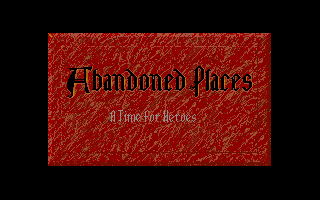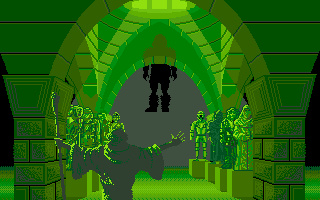From The CRPG Addict
Hungary
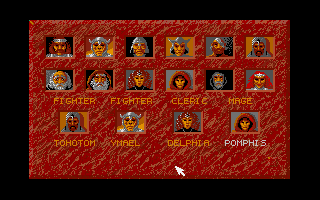 |
| Assembling a party. |
The ancient scrolls have led us to the location of the Heroes, the Champions of Kalynthia, turned into living stone, waiting for the time to once again fight evil. The council emissaries will travel across land and sea to the Temple of Heaven’s Fight. There, far below the surface, the Heroes are to be found, but our powers are waning and we only have the power to turn four of the heroes back to flesh and bone. No one can tell what the effects of 900 years as statues will have on them. But they are now our only hope to stop the cursed Bronakh. May luck be with us all.
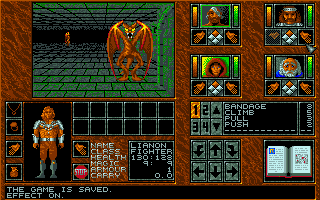 |
| Almost immediately, the game thrusts you into combat. |
The interface is fairly intuitive. You left-click to move objects and right-click to use them. Everything is contained in one window. The developers sacrificed exploration window space to keep the inventory and character sheet always visible. You click on the character portraits to cycle through their inventories. The character with the active inventory and character sheet is different from the character with the active combat options; you change those by clicking the number buttons right next to them. Because of the nature of the interface, you really need a mouse so that you can drag items from the floor to the characters, operate switches, and so forth. But it does offer keyboard options for commands such as movement and–thank you!–attacking. You can also specify the direction of attack with the little pad beneath the character portrait, but I haven’t played with that yet.
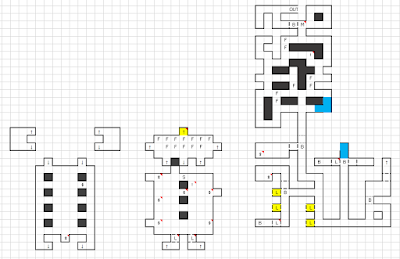 |
| My map of most of the temple. |
The temple ended up being five levels, but with only three of them taking up any substantial space. The goal turned out to be finding the exit on the bottom level, which was the largest, taking up 16 x 29 coordinates, but using nowhere near that much space. (The game uses a “worm tunnel” approach, which automatically cuts out a lot of squares.) Standing in my way were things that looked like gargoyles, skeletons, and maybe fire elementals. They were all pretty easy to kill even though I never found any armor and the only weapons I found were minor ones: clubs, daggers, and one short sword.
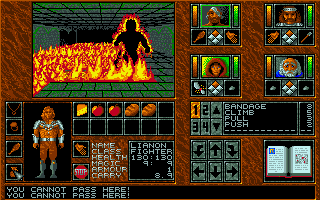 |
| This thing looks like it ought to be harder than it was. |
I like the way the game allocates experience, which is by successful action rather than simply killing someone in combat. Fighters get experience for each hit. Spellcasters get experience for each spell successfully cast, including noncombat ones like “Create Food.” Nonetheless, by the end of the dungeon I did have a rather large experience imbalance in favor of the fighters. No one had reached Level 2 yet, though. I need to spend more time casting spells, since magic regenerates relatively quickly. As in Dungeon Master, a full spell point bar is just wasted potential experience.
Navigation puzzles were easy in the introductory dungeon, consisting of just a few keys, buttoned doors, and levers that opened new sections of hallway. Towards the end of the level, I had to avoid fire squares and water squares, although you can try to cross them quickly if you don’t mind a little damage. The only thing that bothered me was that I left four locked doors on the lower level for which I never found any keys. There was also a stairway on an upper floor that was blocked somehow. Maybe these were red herrings, or maybe we’ll be back to the temple later.
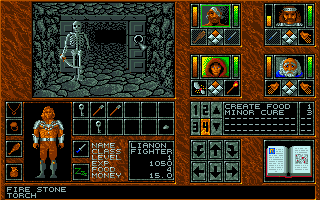 |
| A skeleton comes out of a buttoned door. |
There was a chest full of food on one level, but it barely did anything. If I didn’t have the “Create Food” spell, my characters would have been starving for three-quarters of the expedition. Starvation causes a periodic loss of 1 hit point. I also noted that the game told me the characters were “exhausted” quite early in my explorations and torches didn’t last very long. (By the way, to use a torch in this game, you have to hold a “firestone” in one hand and the torch in another and then right-click on the firestone. That took a while to figure out.) I suspect this all means that I have the cycles set too high in DOSBox. Discussion question: Is there ever a good excuse for a developer to base such considerations on CPU cycles rather than real-time or number of moves? It feels like authors in this era never considered the possibility of faster machines.
When we found the exit to the dungeon, I was surprised to find myself on a top-down overworld map. Well, not completely “surprised” because I’d read the manual, but still–this is an unusual addition to the Dungeon Master sub-genre. The rest of the game takes place over a reasonably large map with one large island and three small ones. The map is dotted with towns, castles, and ruins, and I assume most of them have some kind of dungeon to explore. (The overland map is similar enough to Legend from the UK that I wonder if the developers weren’t influenced by it.) I like the approach, as long as the dungeons are of modest size. If they’re each as large as the typical Dungeon Master clone, the game will wear it its welcome quite fast.
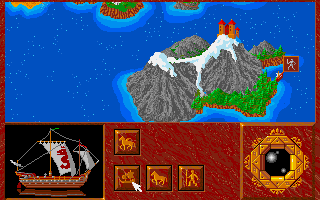 |
| Boarding the boat from the starting island. |
My first goal was getting off the southern island that houses the Temple of Heaven’s Fight. From atop the mountain, I could see a ship making daily trips from the large island to our small one, so we headed for that ship’s port of call. Along the way, the game said we found some horses. There’s a button that lets you switch between various modes of transportation. When we reached the boat, we switched to that, and it brought us to the “continent.”
I headed for the nearest city, which turned out to be a quiet little town called Frampton. It was home to a priest whose services I didn’t need. There were no other shops.
 |
| The town was pretty, though. |
Lacking any guidance about where to go–Why didn’t the mage who awakened us stick around? Or at least leave a note?–I decided to work my way roughly counter-clockwise around the continent. A fortress in the middle of a lake with a long bridge leading to it looked promising. When I arrived, the game told me I was at Pedroc’s Abbey, but that it was closed.
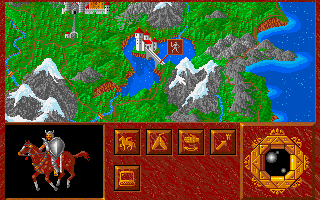 |
| The overworld map has a lot of interesting-looking features. There just isn’t much to do when you get there. |
I continued moving over mountain and river until I came to a small town called Timberville, where “most of the villagers have some kind of weapon in their hands.” Timberville had another healer and a tavern, where we spent the 15 gold pieces found in the temple on a meal (2.0) and lodging (2.5). I’m not sure if either did anything for us, as I stopped getting messages about hunger and fatigue the moment I reached the outdoor map.
You occasionally have to fight wilderness combats, which take you to a small 3D map crossed with bushes and rivers. The only enemies I’ve had to face so far are giant bugs, which drop no gold. You can’t leave the fights until you’ve killed all the enemies, and it can be annoying to find them sometimes.
 |
| Fighting a giant bug in the wilderness. |
I couldn’t even find the entrance to a castle (called “Twilight” on the map) across the lake from Timberville, and two villages further along the coast, Hyde and Trailcross, had the same options as Timberville. Something called the Tower of Scions was destroyed and offered nothing to do. Cities called Iron Home and Tol Al Nerak wanted 10 gold pieces to enter, which is all I had left. I saved and tried anyway, but both just had shops that had nothing I could afford.
 |
| It’s nice to know such things exist. I’ll be richer someday. |
I ultimately spent the gold getting into Kal Kalon, the capital of the country, where I found a guild. The guild leveled up my first fighter and mage–fortunately, for free–and said I need a few hundred experience points more for the other two. I couldn’t take advantage of the other services and left.
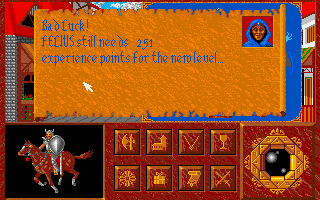 |
| Not so much “bad luck” as “uneven distribution.” |
I finally found something to do at Souls Abbey in the southwest of the main island, nearly a full loop back to where I’d started. A monk told me he might have a job for us, but he’d need us to prove our skills first. He said his guards would take us to a “place full of monsters,” and that we would prove our worth by destroying all of them.
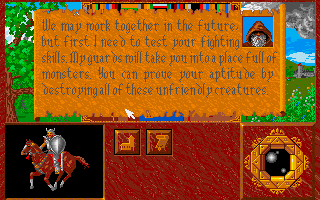 |
| Our first quest. |
We agreed, and soon found ourselves in a new, dark dungeon–the only problem being that we only have one torch left and it’s hard to see in the dark. Hopefully, we’ll find some more.
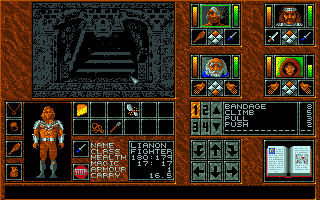 |
| Dropped off in my second dungeon. |
Aside from that hour where I was wandering around the land experiencing nothing, Abandoned Places has started relatively strong. To many players, Dungeon Master is perfectly satisfying on its own, but I’m rather glad to see a game that adds an overworld, an economy, and NPCs to the template. And while I always enjoyed Dungeon Master‘s approach to leveling through action, I’m glad to see it quantified (or perhaps I should say quantified in a way visible to the player) here. My major concerns are whether it will introduce more interesting puzzles than it has already, and whether the game world will open up a bit. It would be a waste of the overland map if you had to hit all the dungeons in a particular order.
Time so far: 4 hours
Original URL: http://crpgaddict.blogspot.com/2020/05/game-366-abandoned-places-time-for.html

